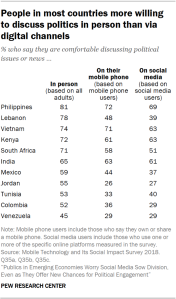
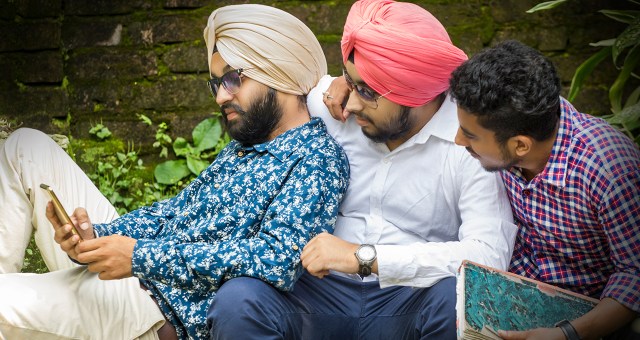
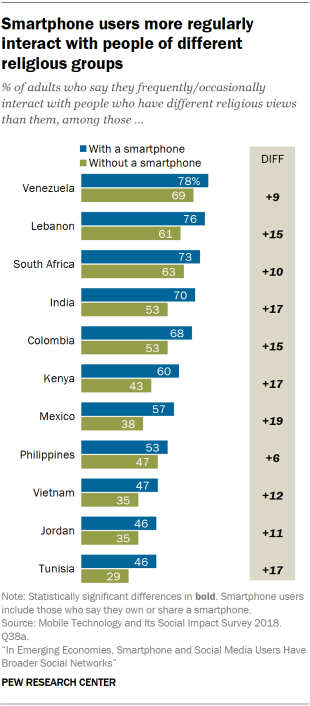
Are smartphones and social media changing social interactions in emerging economies, or are people simply talking to the same people online that they once talked to offline? A Pew Research Center survey of adults in 11 nations across four global regions finds that, in many key respects, smartphone users – and especially those who use social media – are more regularly exposed to people who have different backgrounds and more connected with friends they don’t see in person. Those with smartphones are also more likely to have accessed new information about health and government services.
Across every country surveyed, those who use smartphones are more likely than those who use less sophisticated phones or no phones at all to regularly interact with people from different religious groups. For example, 57% of Mexican smartphone users report frequently or occasionally interacting with people of other religions, compared with 38% of those with less mobile connectivity.
Across most of the 11 emerging economies, people with smartphones also tend to be more likely to interact regularly with people from different political parties, income levels and racial or ethnic backgrounds. Taking Mexico as the example once again, more than half of Mexican smartphone users (54%) regularly interact with people who support different political parties than they do, compared with 30% of those without smartphones. They are also 24 percentage points more likely to interact with people of different income levels and 17 points more likely to interact with people of different racial or ethnic groups.
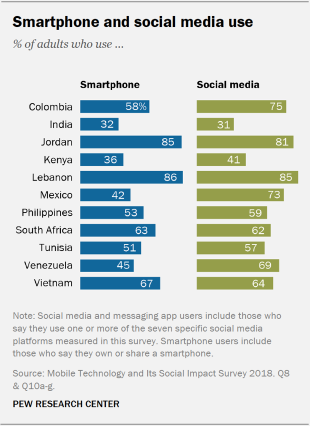
This report is the third in a series exploring mobile connectivity in 11 emerging economies. Because the first report goes into detail on mobile phone ownership and social media use, we will only briefly summarize it here.
In most of the 11 countries surveyed, a majority of adults report using at least one of the seven social media platforms or messaging apps included in this survey: Facebook, WhatsApp, Twitter, Snapchat, Instagram, Viber and Tinder. Social media use is especially common in Lebanon, Jordan, Colombia and Mexico, where about three-quarters or more use at least one of these services. Kenya and India are the only countries where a majority of adults do not use at least one of these social media or messaging services.
In each of these countries, Facebook or WhatsApp is the most widely used digital platform among the seven asked about. A median of 62% of adults in these countries report using Facebook, and a median of 47% say they use WhatsApp. Using multiple social platforms is common: In all countries but the Philippines, India and Vietnam, around a third or more say they currently use more than one social media platform or messaging app. Among adults who use only one of these platforms, Facebook or WhatsApp tends to be dominant.
In most countries, all of these social media and messaging services are more likely to be used by younger adults. Educational gaps in usage are also significant for most of these services, with people who have a secondary education or higher being more likely to use them.
Across these 11 emerging economies, smartphone and social media use are heavily intertwined: A median of 91% of smartphone users in these countries also use social media or messaging apps, while a median of 81% of social media users say they own or share a smartphone. And, as with smartphone users, social media and messaging app users stand apart from non-users in the regularity of their interactions with people who are different from them. For example, 52% of Mexican social media users regularly interact with people of a different income level compared with 28% of non-users.
Throughout this report, median percentages are used to help readers see overall patterns. The median is the middle number in a list of figures sorted in ascending or descending order. In a survey of 11 countries, the median result is the sixth figure on a list of country-level findings ranked in order.
You find yourself having 3,000 friends, but in real life, you only know 50, but you kind of know them because you share comments and you like similar things. It’s like you know them, but you don’t.Woman, 24, Kenya
These results do not show with certainty that smartphones or social media are the cause of people feeling like they have more diversity in their lives. For example, those who have resources to buy and maintain a smartphone are likely to differ in many key ways from those who don’t, and it could be that some combination of those differences drives this phenomenon. Still, statistical modeling indicates that smartphone and social media use are independent predictors of greater social network diversity, holding other factors constant such as age, education and sex (for more information, see Appendix A).
Additionally, the results of other questions indicate that mobile phones and social media are broadening people’s social networks. For instance, more than half in most countries say they see in person only about half or fewer of the people they call or text. Mobile phones are allowing many to stay in touch with people who live far away: A median of 93% of mobile phone users across the 11 countries surveyed say their phones have mostly helped them keep in touch with those who are far-flung – the most cited benefit of mobile phones among the five asked about on the survey.
When it comes to social media, large shares report relationships with “friends” online who are distinct from those they see in person. A median of 46% of Facebook users across the 11 countries report seeing few or none of their Facebook friends in person regularly, compared with a median of 31% of Facebook users who often see most or all of their Facebook friends in person. In focus groups, a theme that arose was the way in which social media – especially Facebook – allowed people to rekindle past friendships or to find past acquaintances in a way that felt rewarding (for more information on the focus groups, see Appendix B).
It’s important to us that we can call and text [our children].Woman, 40, Philippines
Although smartphones and social media may be broadening horizons, adults in these emerging economies see both positives and negatives stemming from this change. As results from an earlier Pew Research Center report indicate, adults in these 11 countries say access to mobile phones, the internet and social media both make people more divided in their political opinions and sometimes more accepting of those who have different views than they do. And, in most countries, larger shares say technology is causing people to be more divided than say it has caused them to be open to different groups of people.
Social activities are most common for phone users
While people can use their phones for myriad activities, among the most common are casual, social activities. For example, a median of 82% of mobile phone users in the 11 countries surveyed say they used their phone over the past year to send text messages and a median of 69% of users say they took pictures or videos. And, among mobile phone and social media users, a majority in every country also posted pictures or videos to social media. More than half of mobile phone and social media users in most countries also posted their thoughts on social media about issues that are important to them.
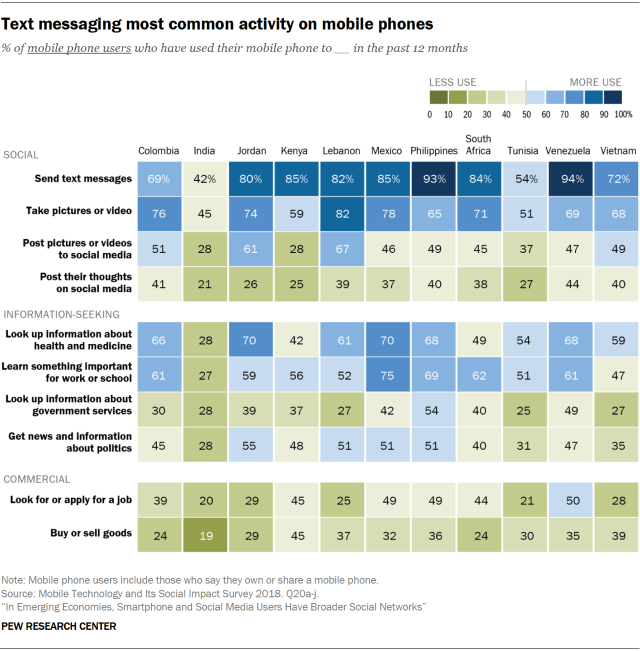
It is also useful at work … like meeting new prospects and clients. It gives you the opportunity to sell products to people.Man, 21, Tunisia
Many mobile phone users are also using their phones to find new information. For example, a median of 61% of mobile phone users say they used their phones over the past year to look up information about health and medicine for themselves or their families. This is more than the proportion that reports using their phones to get news and information about politics (median of 47%) or to look up information about government services (37%), though these activities, too, are prevalent in some countries, including the Philippines, where half or more report doing each of these things over the last year. Additionally, around half or more of mobile phone users in nearly all countries report having used their phones over the past 12 months to learn something important for work or school.
In addition to these activities, some turn to their phones for commerce. For example, a median of 39% of mobile phone users say they used their phones over the past year to look for or apply for a job, and a median of 32% say they used their phones to buy or sell goods. Majorities in most countries say their phones have helped their ability to earn a living. Focus group participants often highlighted the way their phones enhance their ability to reach clients, to schedule work shifts or to market their businesses.
Digital divides emerge in the new mobile-social environment
While phones and social media afford new opportunities to interact with different sorts of people and information, not everyone participates in these activities equally. People with smartphones and social media, as well as younger people, those with higher levels of education and men are in some ways reaping more benefits than others, potentially contributing to digital divides.
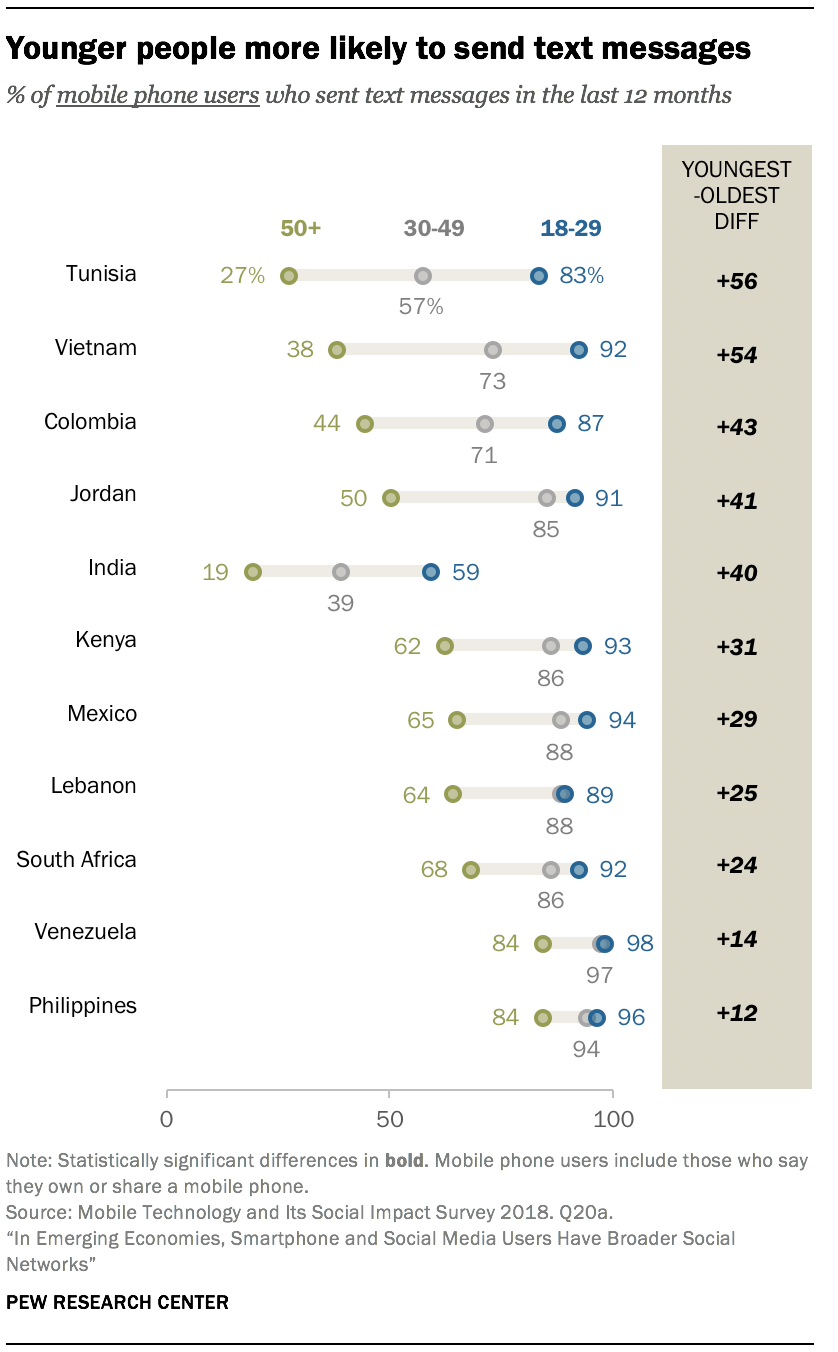
First, people with smartphones are much more likely to engage in activities on their phones than people with less sophisticated devices – even if the activity itself is quite simple. For example, people with smartphones are more likely than those with feature or basic phones to send text messages in each of the 11 countries surveyed, even though the activity is technically feasible from all mobile phones.1 And, although buying and selling goods may be feasible from a basic phone, people with smartphones are much more likely to have participated in these commercial activities than those with other types of devices.
When it comes to activities that are easier with smartphone access – such as seeking information – the differences among those with different levels of access to various phone types in these countries are pronounced. Those who have smartphones are much more likely to look up information for their households, including about health and government services. Differences between smartphone users and other mobile phone users are also pronounced in all countries surveyed when it comes to the regularity with which people interact with those who are different from them.
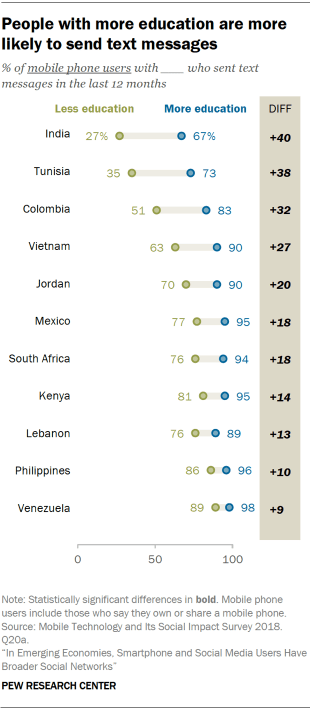
In most countries, the largest differences with regard to social network diversity and what people do on their phones comes between those with smartphones and those with basic phones. In fact, outside of India, there are few differences between those who lack phones and those who have basic phones in terms of how often people interact with those who have different backgrounds than they do. Some of this may be due to the fact that those with smartphones tend to be social media users, and social media use is related to social network diversity, even after accounting for smartphone ownership (see Appendix A).
There are also major differences by age and education level in how their devices are – or are not – broadening their horizons. Younger people are more likely to use their phones for nearly all activities asked about, whether those activities are social, information-seeking or commercial. For example, those under 30 in most countries are around twice as likely – or more – as those ages 50 and older to send text messages, take pictures, buy and sell goods and more. Younger mobile phone users are also more likely to say they encounter different sorts of people in their day-to-day lives. Phone users with higher levels of education are also more likely to do most activities on their phones and to interact with those who are different from them regularly than those with lower levels of education.2
Gender, too, plays a role in what people do with their devices and how they are exposed to different people and information. Men are more likely than women to say they encounter people who are different from them, whether in terms of race, politics, religion or income.3 And men also tend to be more likely to look up information about government services and to obtain political news and information. Men also are more likely to have used their phones over the past year for commerce – both in terms of looking for jobs and buying or selling goods.
These are among the major findings from a Pew Research Center survey conducted among 28,122 adults in 11 countries from Sept. 7 to Dec. 7, 2018. In addition to the survey, the Center conducted focus groups with diverse groups of participants in Kenya, Mexico, the Philippines and Tunisia in March 2018, and their comments are included throughout the report (see Appendix B for more information).




